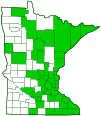Japanese knotweed
(Reynoutria japonica)
Conservation • Weed • Wetland • Description • Habitat • Ecology • Use • Distribution • Taxonomy
Description |
||
Japanese knotweed is a 3½′ to 10′ tall, erect, perennial forb that rises from a long, horizontal, spreading, underground stem (rhizome). It often forms a dense thicket. It spreads aggressively and can form colonies up to an acre in size. The stems are annual, erect or arching, stout, hollow, and hairless. They are unbranched or few-branched, round in cross section, somewhat zigzagged, and swollen at the nodes. They are light green, often with reddish spots, or reddish-brown. Above each node the stem is surrounded by a papery, fringed sheath (ocrea). Older stems are finely ridged. The leaves are alternate, deciduous, stalked, broadly oval, 3″ to 6″ long, and 2″ to 4¾″ wide. The base of the leaf is usually broad and straight across, sometimes slightly heart-shaped. The blade tapers to a point at the tip with concave sides along the tip. The upper surface is hairless. The lower surface is minutely rough-hairy along some of the veins. The hairs are not visible without a hand lens. The margins are untoothed. The inflorescence is a branched, elongated, erect, 3″ to 6″ long cluster (panicle) of numerous flowers rising from upper leaf axils. In its native range each plant produces either flowers with both fertile male and fertile female parts or flowers with infertile male and fertile female parts. In North America only the latter have been introduced. The flowers are white or greenish-white and bell-shaped. There are 5 tepals consisting of 2 small inner petals and 3 larger, outer, keeled, petal-like sepals. The tepals are fused at the base. Male flowers have 6 to 8 reduced, nonfunctional stamens (staminodes). Female flowers have 3 spreading styles. The fruit is a shiny, dark brown, hairless, three-angled, 1 ⁄16″ to ⅛″ long nut (achene). |
||
Height |
||
3½′ to 10′ |
||
Flower Color |
||
White to greenish |
||
Similar Species |
||
| Giant knotweed (Reynoutria sachalinensis) is a vine, not an erect plant. | ||
Habitat |
||
Moist to moderate moisture. Woods, fence rows, roadsides. Full to partial sun. |
||
Ecology |
||
Flowering |
||
August to September |
||
Propagation |
||
In North America only plants with fertile female and infertile male plants have been introduced. The plant spreads by an extensive rhizome system. Having no fertile male flowers the plant cannot produce by reseeding. Fragments of stem or rhizome can produce new plants. Dispersal occurs when plant fragments are washed downstream or are inadvertently transported in dirt by humans. |
||
Pests and Diseases |
||
|
||
Use |
||
|
||
Distribution |
||||
|
Sources |
|||
| 3/18/2023 | ||||
Nativity |
||||
Native to Japan, Korea, Taiwan, and China. Introduced and naturalized in the United States and Canada. Escaped cultivation. |
||||
Occurrence |
||||
|
||||
Taxonomy |
|||
| Kingdom | Plantae (Plants) | ||
| Division | Tracheophyta (Vascular Plants) | ||
| Subdivision | Spermatophytina (Seed Plants) | ||
| Class | Magnoliopsida (Dicots) | ||
| Superorder | Caryophyllanae | ||
Order |
Caryophyllales (Pinks, Cactuses, and Allies) | ||
Family |
Polygonaceae (knotweed) | ||
| Subfamily | Polygonoideae | ||
| Tribe | Polygoneae | ||
| Subtribe | Reynoutriinae | ||
Genus |
Reynoutria | ||
Subordinate Taxa |
|||
|
|||
Synonyms |
|||
Fallopia japonica var. japonica Pleuropterus cuspidatus Pleuropterus zuccarinii Polygonum cuspidatum Polygonum cuspidatum var. compactum Polygonum zuccarinii |
|||
Common Names |
|||
fleeceflower Japanese knotweed Mexican bamboo |
|||
Glossary
Achene
A dry, one-chambered, single-seeded seed capsule, formed from a single carpel, with the seed attached to the membranous outer layer (wall) only by the seed stalk; the wall, formed entirely from the wall of the superior ovary, does not split open at maturity, but relies on decay or predation to release the contents.
Axil
The upper angle where a branch, stem, leaf stalk, or vein diverges.
Keeled
Folded, as in a grass blade, or with a raised ridge, as in a grass sheath; like the keel of a boat.
Node
The small swelling of the stem from which one or more leaves, branches, or buds originate.
Ocrea
A sheath around the stem at the base of a petiole formed from the stipules; a feature of many members of the Polygonaceae.
Panicle
A pyramidal inflorescence with a main stem and branches. Flowers on the lower, longer branches mature earlier than those on the shorter, upper ones.
Rhizome
A horizontal, usually underground stem. It serves as a reproductive structure, producing roots below and shoots above at the nodes.
Staminode
A modified stamen that produces no pollen. It often has no anther.
Tepal
Refers to both the petals and the sepals of a flower when they are similar in appearance and difficult to tell apart. Tepals are common in lilies and tulips.
Visitor Photos |
|||||
Share your photo of this plant. |
|||||
| This button not working for you? Simply email us at info@MinnesotaSeasons.com. Attach one or more photos and, if you like, a caption. |
|||||
|
|||||
MinnesotaSeasons.com Photos |
|||||
Plant |
|||||
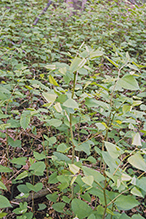 |
|||||
Leaves |
|||||
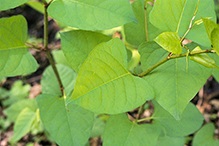 |
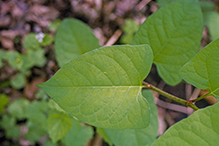 |
||||
Stem |
|||||
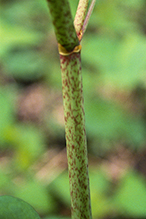 |
|||||

Slideshows |
||
| Fallopia japonica Susanne Wiik |
||

|
||
About
Parkslirekne, Japanese knotweed |
||
| Japanese Knotweed Wez Smith |
||

|
||
About
Japanese Knotweed (Fallopia japonica). |
||
| Japanese Knotweed Identification Invasive Weeds Agency |
||
About
Published Jan 25, 2013 How to identify Japanese knotweed (Fallopia japonica) throughout the year. Find more info at Invasive Weeds Agency's website. |
||

Visitor Videos |
|||
Share your video of this plant. |
|||
| This button not working for you? Simply email us at info@MinnesotaSeasons.com. Attach a video, a YouTube link, or a cloud storage link. |
|||
Other Videos |
|||
| The plant that breaks through concrete One Minute Environment |
|||
About
Uploaded Jun 30, 2011 The Japanese Knotweed (Fallopia japonica) is by law banned from Switzerland. It spreads nevertheless. It can breakt through concrete and pushes out native plants. |
|||
| Japanese Knotweed backyardfarmer |
|||
About
Uploaded May 20, 2011 UNL Extension Educator Nicole Haxton shows us what Japanese Knotweed looks like and discusses strategies to control it. |
|||
| Invasive Species: Japanese Knotweed Cindy Sandeno |
|||
About
Published on Jun 22, 2012 Potomac Highlands Cooperative Weed and Pest Management Area short film about the invasive species: Japanese Knotweed. Identification, the problems, and treatment of Tree of Heaven. |
|||

Visitor Sightings |
|||||
Report a sighting of this plant. |
|||||
| This button not working for you? Simply email us at info@MinnesotaSeasons.com. Be sure to include a location. |
|||||
| Debbie 8/15/2018 |
Location: Grant (Washington County) Starting to see it all over the place! |
||||
| Tia 4/20/2016 |
Location: Shelton Washington pain in the button, taken over acre |
||||
MinnesotaSeasons.com Sightings |
|||||

|
Created: Last Updated: © MinnesotaSeasons.com. All rights reserved. |
